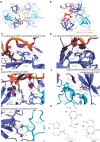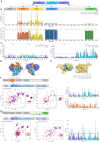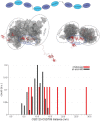Upstream of N-Ras C-terminal cold shock domains mediate poly(A) specificity in a novel RNA recognition mode and bind poly(A) binding protein
- PMID: 36688322
- PMCID: PMC9976900
- DOI: 10.1093/nar/gkac1277
Upstream of N-Ras C-terminal cold shock domains mediate poly(A) specificity in a novel RNA recognition mode and bind poly(A) binding protein
Abstract
RNA binding proteins (RBPs) often engage multiple RNA binding domains (RBDs) to increase target specificity and affinity. However, the complexity of target recognition of multiple RBDs remains largely unexplored. Here we use Upstream of N-Ras (Unr), a multidomain RBP, to demonstrate how multiple RBDs orchestrate target specificity. A crystal structure of the three C-terminal RNA binding cold-shock domains (CSD) of Unr bound to a poly(A) sequence exemplifies how recognition goes beyond the classical ππ-stacking in CSDs. Further structural studies reveal several interaction surfaces between the N-terminal and C-terminal part of Unr with the poly(A)-binding protein (pAbp). All interactions are validated by mutational analyses and the high-resolution structures presented here will guide further studies to understand how both proteins act together in cellular processes.
© The Author(s) 2023. Published by Oxford University Press on behalf of Nucleic Acids Research.
Figures







Similar articles
-
Pseudo-RNA-Binding Domains Mediate RNA Structure Specificity in Upstream of N-Ras.Cell Rep. 2020 Jul 21;32(3):107930. doi: 10.1016/j.celrep.2020.107930. Cell Rep. 2020. PMID: 32697992 Free PMC article.
-
The NMR solution structures of the five constituent cold-shock domains (CSD) of the human UNR (upstream of N-ras) protein.J Struct Funct Genomics. 2010 Jun;11(2):181-8. doi: 10.1007/s10969-010-9081-z. Epub 2010 Mar 6. J Struct Funct Genomics. 2010. PMID: 20213426
-
RNA binding specificity of Unr, a protein with five cold shock domains.Nucleic Acids Res. 1999 Apr 15;27(8):1926-34. doi: 10.1093/nar/27.8.1926. Nucleic Acids Res. 1999. PMID: 10101203 Free PMC article.
-
Y-box proteins combine versatile cold shock domains and arginine-rich motifs (ARMs) for pleiotropic functions in RNA biology.Biochem J. 2018 Sep 11;475(17):2769-2784. doi: 10.1042/BCJ20170956. Biochem J. 2018. PMID: 30206185 Review.
-
La proteins couple use of sequence-specific and non-specific binding modes to engage RNA substrates.RNA Biol. 2021 Feb;18(2):168-177. doi: 10.1080/15476286.2019.1582955. Epub 2019 Mar 18. RNA Biol. 2021. PMID: 30777481 Free PMC article. Review.
Cited by
-
Exploring the dynamics of messenger ribonucleoprotein-mediated translation repression.Biochem Soc Trans. 2024 Dec 19;52(6):2267-2279. doi: 10.1042/BST20231240. Biochem Soc Trans. 2024. PMID: 39601754 Free PMC article. Review.
-
Emerging roles of RNA binding proteins in intervertebral disc degeneration and osteoarthritis.Orthop Surg. 2023 Dec;15(12):3015-3025. doi: 10.1111/os.13851. Epub 2023 Oct 6. Orthop Surg. 2023. PMID: 37803912 Free PMC article. Review.
-
CSDE1: a versatile regulator of gene expression in cancer.NAR Cancer. 2024 Apr 10;6(2):zcae014. doi: 10.1093/narcan/zcae014. eCollection 2024 Jun. NAR Cancer. 2024. PMID: 38600987 Free PMC article.
References
-
- Bieri P., Greber B.J., Ban N.. High-resolution structures of mitochondrial ribosomes and their functional implications. Curr. Opin. Struct. Biol. 2018; 49:44–53. - PubMed
-
- Voorhees R.M., Ramakrishnan V.. Structural basis of the translational elongation cycle. Annu. Rev. Biochem. 2013; 82:203–236. - PubMed
-
- Sainsbury S., Bernecky C., Cramer P.. Structural basis of transcription initiation by RNA polymerase iI. Nat. Rev. Mol. Cell Biol. 2015; 16:129–143. - PubMed
Publication types
MeSH terms
Substances
LinkOut - more resources
Full Text Sources
Molecular Biology Databases
Miscellaneous

